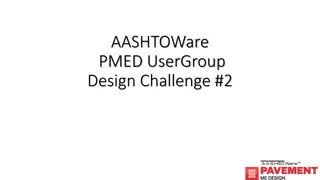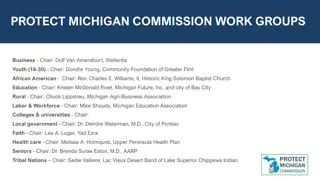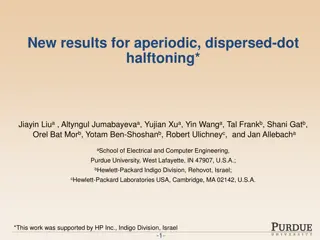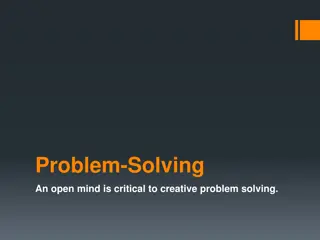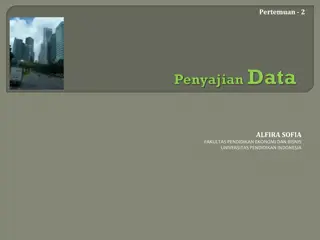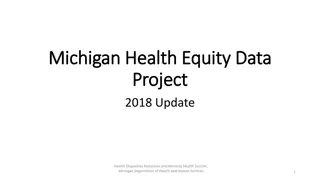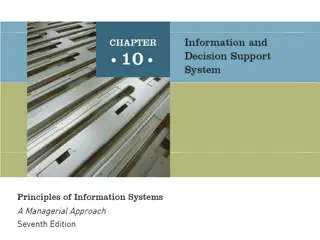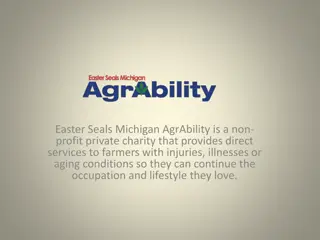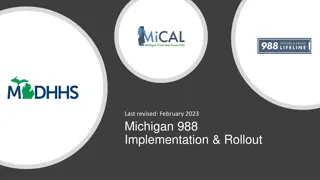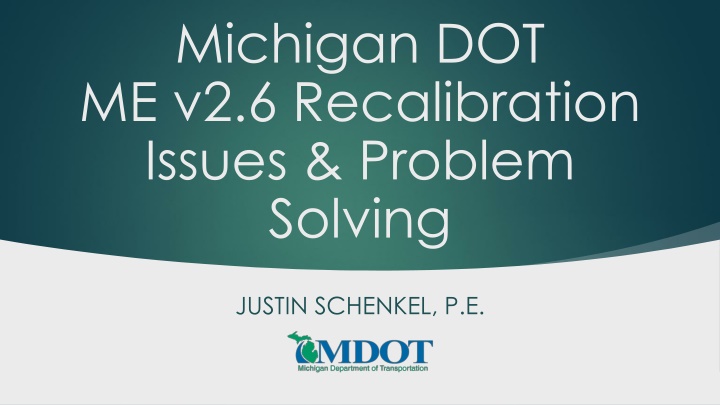
Michigan DOT Version 2.6 Recalibration and Problem Solving Issues
Explore the challenges and solutions related to the recalibration of Michigan DOT version 2.6, addressing performance data conversions, JPCP faulting data, thermal cracking limits, and more. Discover insights into using Pavement-ME for design decisions and the practicalities of calibration modifications.
Download Presentation

Please find below an Image/Link to download the presentation.
The content on the website is provided AS IS for your information and personal use only. It may not be sold, licensed, or shared on other websites without obtaining consent from the author. If you encounter any issues during the download, it is possible that the publisher has removed the file from their server.
You are allowed to download the files provided on this website for personal or commercial use, subject to the condition that they are used lawfully. All files are the property of their respective owners.
The content on the website is provided AS IS for your information and personal use only. It may not be sold, licensed, or shared on other websites without obtaining consent from the author.
E N D
Presentation Transcript
Michigan DOT ME v2.6 Recalibration Issues & Problem Solving JUSTIN SCHENKEL, P.E.
Using Pavement-ME for design decisions since ~2014 Currently using v2.3 Using Pavement-ME for new/recon only JPCP - using Global Coefficients (not enough sections & premature performance data) HMA - using Local Coefficients MDOT Background Recalibration for v2.6 Have library for: HMA, Subgrade, Climate, Traffic Have general inputs for: JPCP, Unbound Base/Subbase
V2.6 Recalibration Issues To Address Performance Data Conversions MDOT JPCP Faulting Data ME Thermal Cracking Limit How to Define Bottom-Up vs Top-Down Cracking? Initial IRI Backcasting Practicality of Calibration ME Calibration Coefficient Modifications ME Material Input Modifications (HMA inputs) Climate MERRA vs Groundbased (NARR/ASOS) CAT Limitations
Performance Data Conversions Pavement Type MDOT units Pvmt-ME units Conversion needed? Distress Needed to convert MDOT data to fit Pavement-ME data format. IRI in/mile in/mile No Top-down Cracking miles % area Yes This requires understanding of: Bottom-up Cracking MDOT data collection parameters, assumptions, and equipment. miles % area Yes FLEXIBLE Thermal Cracking No. of occurrences ft/mile Yes Pavement-ME expectations and limitations. Rutting in in No As a result, we needed to make assumptions about how best to represent the data for Pavement-ME. Reflective Cracking None % area N/A IRI in/mile in/mile No RIGID Faulting in In Yes Transverse Cracking No. of occurrences % slabs cracked Yes
MDOT JPCP Faulting Data Pavement-ME faulting is predicted as average per joint. MDOT faulting per 0.1 mile at cracks and joints (incl. repaired joints). If number of faults is greater than the possible number of joints, that 0.1-mile datapoint is omitted. Used following to convert MDOT faulting: Fault = [(FAULnum FAULi)/Njoints] FAULnum= number of faults in a 0.1 mile FAULi= Average faulting in a 0.1 mile (inches) Njointsis the number of joints in 0.1-mile (528 ft) segments, i.e., Njoints=528/Joint Spacing. Also, MDOT fault values between 2000 to 2011 are max values (not avg values) Used correlation between max fault & avg for other years to approx. 2000 to 2011 avg faulting.
ME Thermal Cracking Limit ME caps thermal cracking to 2112 ft/mile MDOT has actual thermal cracking up to 8000 ft/mile with several points above 2112 ft/mile Needed to determine how to address points above 2112 ft/mile: Remove or reduce to 2112 ft/mile. Research recommended removing them.
MINIMUM HMA THICKNESS FOR TD CRACKING (LOWER THICKNESS IS BU) HMA Threshold thickness (in) How to Define Bottom-Up vs Top-Down Cracking? Surface type HMA over rubblized PCC HMA over Composite HMA over Crush and Shape HMA over HMA New or reconstruct 6 6 4 6 5
Initial IRI Backcasting Used different methods to estimate initial IRI: Selected initial IRI value: a) Linear backcasting per measured data for first ten years b) Linear backcasting IRI per measured data for all available years c) Reducing first measured IRI by 5 each year to the 0 year d) Reducing first measured IRI to the 0 year by: 5 each year if greater than 100 4 each year if between 70 and 100 3 each year if less than 70 1. If first measured IRI spec limit (70 or 75): Use initial IRI with closest match to first measured IRI (without being greater). 2. If first measured IRI > spec limit: Use closest initial IRI value less than spec limit. If not less than spec limit, then use closest IRI0 greater than the spec limit. 3. Subsequently, review data progression to see if estimated initial IRI fits and adjust the IRI0value up or down (if needed). Projects selected for HMA IRI calibration: Have initial IRI less than spec limit plus some tolerance (due to expected IRI variability)
Practicality of Calibration Once we received coefficients; MDOT tested them on our back catalog of past designs to determine their practicality and issues. Repeat until no further issues.
ME Calibration Coefficient Modifications Mean Avg Air Temp (MAAT) HMA Top-Down Cracking HMA Thickness We found colder MAAT had inverse transverse cracking result than expected; Houghton (colder) had lower cracking than Detroit (warmer). To solve this issue, we used the v2.3 single value input for calibration. For calibration, HMA thickness bins established for BU Fatigue Cracking. We needed to evaluate our dataset to determine if these bins were appropriate. Difficulty in calibration due to error in adjustment of coefficients. Needed to use more simplistic approach to modify coefficients. Unfortunately, calibration results produce no difference in predicted cracking for any designs.
HMA input changes - aggregate gradation & binder content % ME material input modifications Needed to: Find and/or recommend new inputs that didn t previously exist. Evaluate how inputs impact the designs.
Climate MERRA vs Groundbased (NARR & ASOS) Benefits of Each Estimated Importance Groundbased (NARR/ASOS MTU Updated) - SELECTED OPTION - MERRA Future Pavement ME, climatic models will may use inputs only available in MERRA (incl. short-wave absorptivity, etc.) MERRA has data issues that groundbased doesn t have humidity, sunshine, and precipitation errors. Very High Individual station locations are actual data from collected values, so these are more accurate and even more so due to MTU process and MI specific evaluation More station locations to choose from (39 vs ~50 equally spaced) High More years of data? Less years of data? Data quantity additions & corrections are continuous per external group Moderate (NARR requires manual MDOT update process) No need to exclude erroneous data points that may be in the Great Lakes (some MERRA stations should be excluded because of this) ME global coefficients are (or will be) derived from MERRA Low Most other agencies will be using MERRA
CAT Limitations For calibration factors - limited number of runs and combinations Depends on server and time delay Must use the same design types (recon vs rehab, etc.) Time consuming to upload and run designs
Sincere thanks to the Research Team Syed Waqar Haider, M. Emin Kutay, Bora Cetin, Rahul Raj Singh, Hamad Bin Muslim, and Celso Santos (Michigan State University) Zhanping You (Michigan Technological University) Acknowledgments Will Hansen (University of Michigan)
MDOT Next Steps Present research & calibration results to MDOT & Industry Partners Present Update Update MDOT User Guide Implement new local calibration coefficients per ME v2.6 Implement Conduct new research to finalize MDOT protocols for rehab designs in ME New Research

![[PDF⚡READ❤ONLINE] Planet Mercury: From Pale Pink Dot to Dynamic World (Springer](/thumb/21549/pdf-read-online-planet-mercury-from-pale-pink-dot-to-dynamic-world-springer.jpg)


